Taxation Theory, Practice: Asset Tax Liability Analysis Report
VerifiedAdded on 2020/11/23
|12
|3325
|48
Report
AI Summary
This report provides a comprehensive analysis of Australian taxation, focusing on the tax liabilities of an antique collector. It examines various assets, including vacant land, an antique bed, a painting, shares, and a violin, applying relevant Australian tax laws and regulations. The report delves into capital gains tax (CGT) calculations, considering indexation, cost bases, and sale proceeds for each asset. It also addresses pre-CGT assets and the implications of insurance claims. Furthermore, the report analyzes the tax consequences of share portfolios, including the calculation of capital gains and losses. The analysis extends to the valuation of assets and the application of relevant sections of the Income Tax Assessment Act 1997. The report serves as a practical guide to understanding taxation theory and practice in the Australian context, offering insights for tax consultants and investors alike.
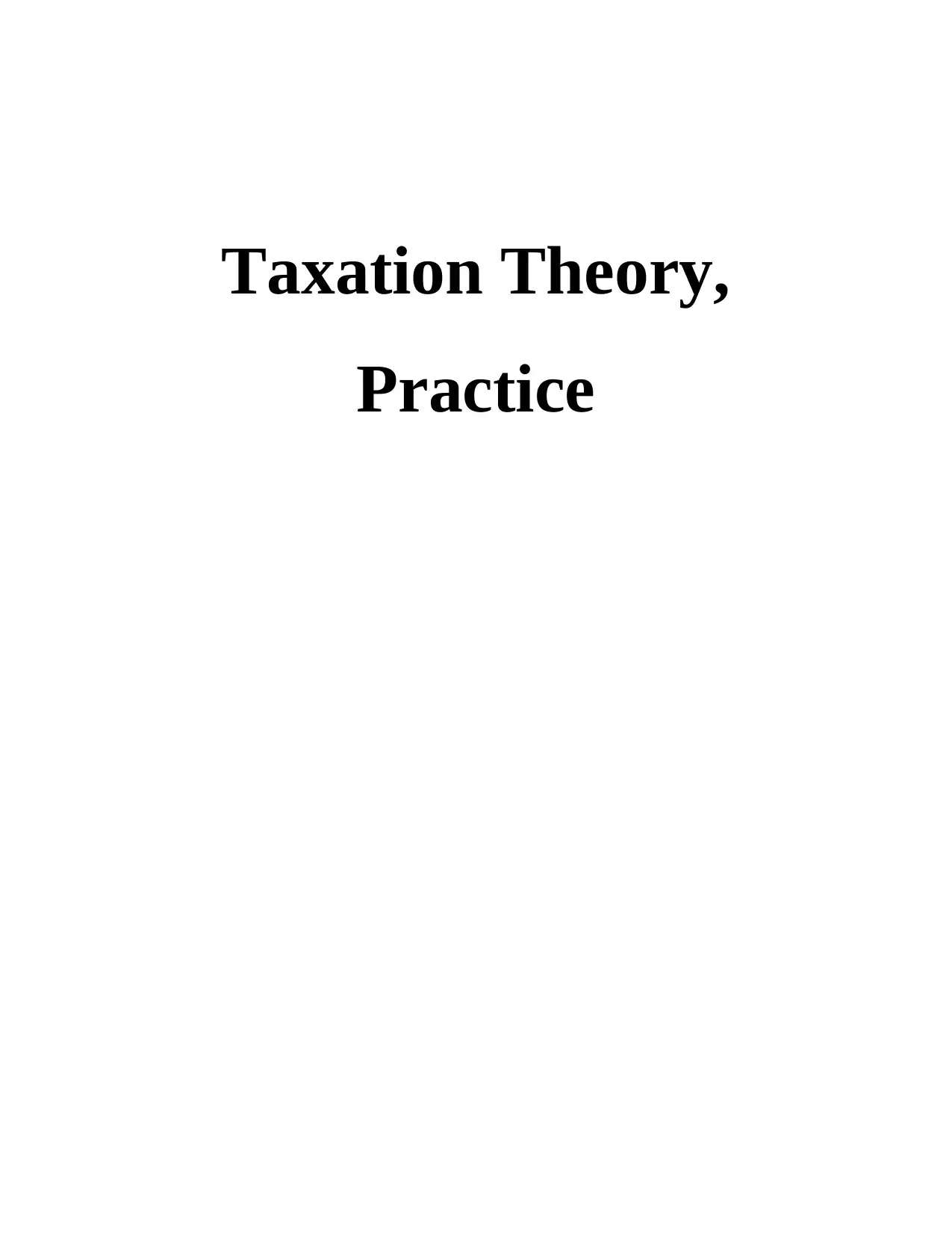
Taxation Theory,
Practice
Practice
Paraphrase This Document
Need a fresh take? Get an instant paraphrase of this document with our AI Paraphraser
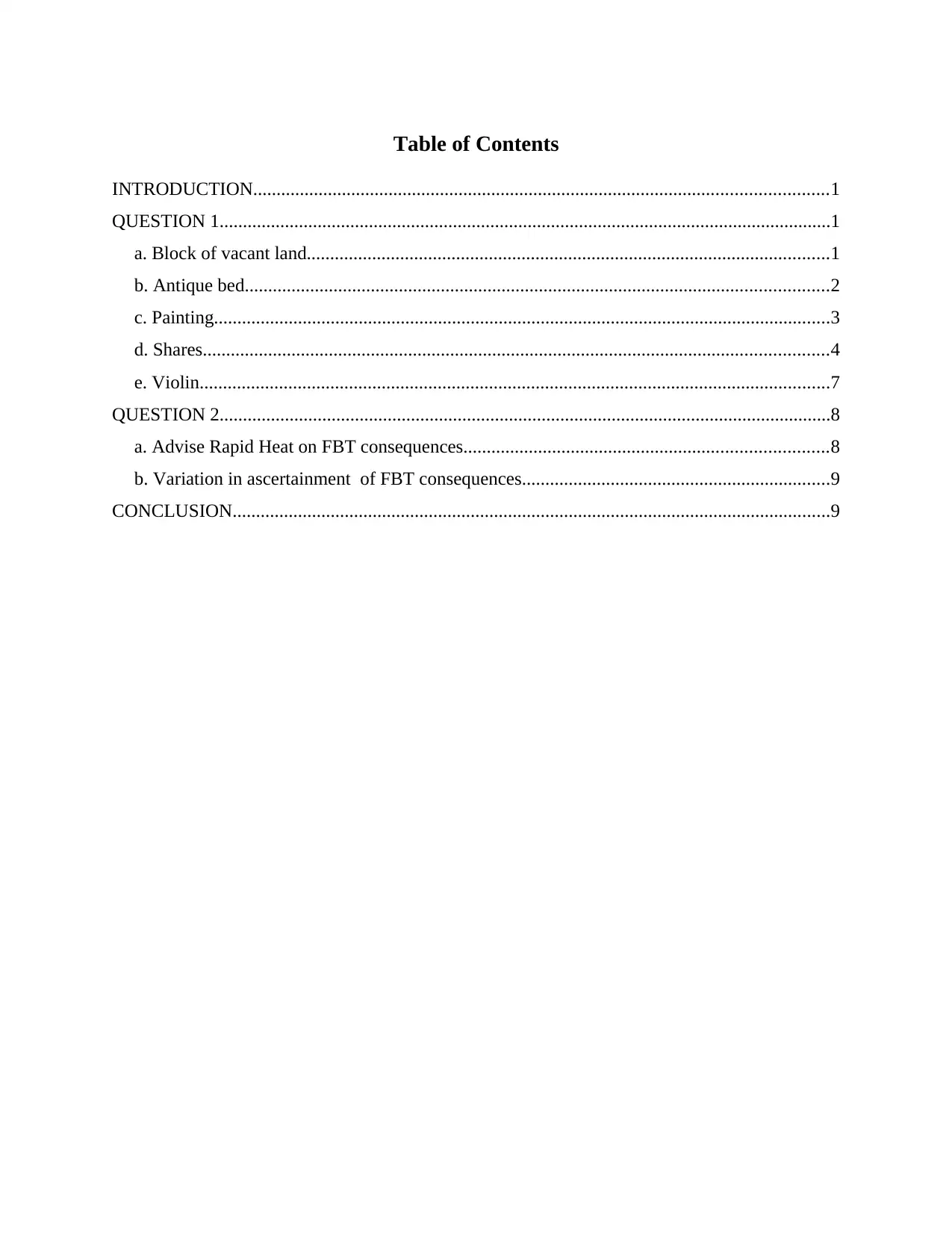
Table of Contents
INTRODUCTION...........................................................................................................................1
QUESTION 1...................................................................................................................................1
a. Block of vacant land................................................................................................................1
b. Antique bed.............................................................................................................................2
c. Painting....................................................................................................................................3
d. Shares......................................................................................................................................4
e. Violin.......................................................................................................................................7
QUESTION 2...................................................................................................................................8
a. Advise Rapid Heat on FBT consequences..............................................................................8
b. Variation in ascertainment of FBT consequences..................................................................9
CONCLUSION................................................................................................................................9
INTRODUCTION...........................................................................................................................1
QUESTION 1...................................................................................................................................1
a. Block of vacant land................................................................................................................1
b. Antique bed.............................................................................................................................2
c. Painting....................................................................................................................................3
d. Shares......................................................................................................................................4
e. Violin.......................................................................................................................................7
QUESTION 2...................................................................................................................................8
a. Advise Rapid Heat on FBT consequences..............................................................................8
b. Variation in ascertainment of FBT consequences..................................................................9
CONCLUSION................................................................................................................................9
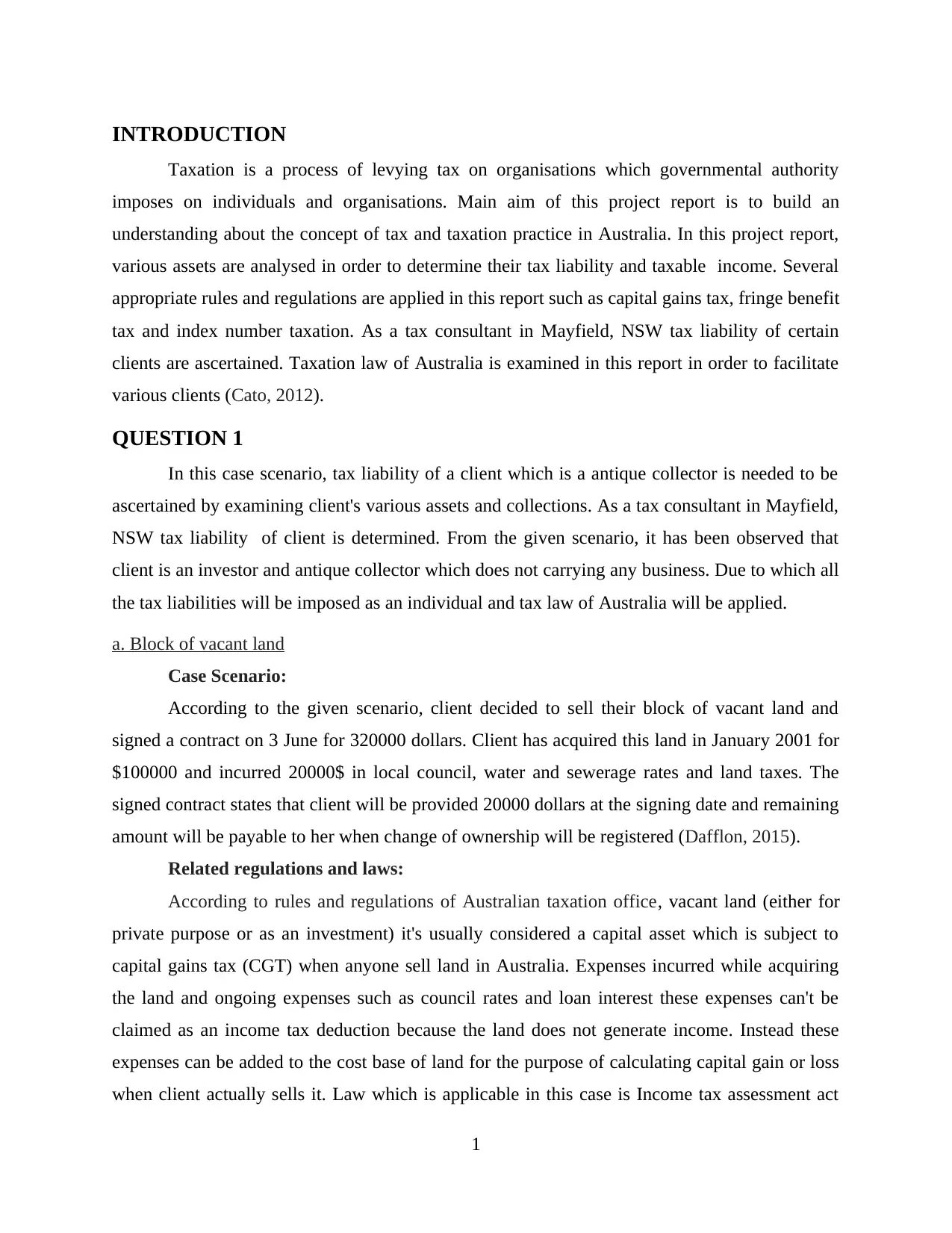
INTRODUCTION
Taxation is a process of levying tax on organisations which governmental authority
imposes on individuals and organisations. Main aim of this project report is to build an
understanding about the concept of tax and taxation practice in Australia. In this project report,
various assets are analysed in order to determine their tax liability and taxable income. Several
appropriate rules and regulations are applied in this report such as capital gains tax, fringe benefit
tax and index number taxation. As a tax consultant in Mayfield, NSW tax liability of certain
clients are ascertained. Taxation law of Australia is examined in this report in order to facilitate
various clients (Cato, 2012).
QUESTION 1
In this case scenario, tax liability of a client which is a antique collector is needed to be
ascertained by examining client's various assets and collections. As a tax consultant in Mayfield,
NSW tax liability of client is determined. From the given scenario, it has been observed that
client is an investor and antique collector which does not carrying any business. Due to which all
the tax liabilities will be imposed as an individual and tax law of Australia will be applied.
a. Block of vacant land
Case Scenario:
According to the given scenario, client decided to sell their block of vacant land and
signed a contract on 3 June for 320000 dollars. Client has acquired this land in January 2001 for
$100000 and incurred 20000$ in local council, water and sewerage rates and land taxes. The
signed contract states that client will be provided 20000 dollars at the signing date and remaining
amount will be payable to her when change of ownership will be registered (Dafflon, 2015).
Related regulations and laws:
According to rules and regulations of Australian taxation office, vacant land (either for
private purpose or as an investment) it's usually considered a capital asset which is subject to
capital gains tax (CGT) when anyone sell land in Australia. Expenses incurred while acquiring
the land and ongoing expenses such as council rates and loan interest these expenses can't be
claimed as an income tax deduction because the land does not generate income. Instead these
expenses can be added to the cost base of land for the purpose of calculating capital gain or loss
when client actually sells it. Law which is applicable in this case is Income tax assessment act
1
Taxation is a process of levying tax on organisations which governmental authority
imposes on individuals and organisations. Main aim of this project report is to build an
understanding about the concept of tax and taxation practice in Australia. In this project report,
various assets are analysed in order to determine their tax liability and taxable income. Several
appropriate rules and regulations are applied in this report such as capital gains tax, fringe benefit
tax and index number taxation. As a tax consultant in Mayfield, NSW tax liability of certain
clients are ascertained. Taxation law of Australia is examined in this report in order to facilitate
various clients (Cato, 2012).
QUESTION 1
In this case scenario, tax liability of a client which is a antique collector is needed to be
ascertained by examining client's various assets and collections. As a tax consultant in Mayfield,
NSW tax liability of client is determined. From the given scenario, it has been observed that
client is an investor and antique collector which does not carrying any business. Due to which all
the tax liabilities will be imposed as an individual and tax law of Australia will be applied.
a. Block of vacant land
Case Scenario:
According to the given scenario, client decided to sell their block of vacant land and
signed a contract on 3 June for 320000 dollars. Client has acquired this land in January 2001 for
$100000 and incurred 20000$ in local council, water and sewerage rates and land taxes. The
signed contract states that client will be provided 20000 dollars at the signing date and remaining
amount will be payable to her when change of ownership will be registered (Dafflon, 2015).
Related regulations and laws:
According to rules and regulations of Australian taxation office, vacant land (either for
private purpose or as an investment) it's usually considered a capital asset which is subject to
capital gains tax (CGT) when anyone sell land in Australia. Expenses incurred while acquiring
the land and ongoing expenses such as council rates and loan interest these expenses can't be
claimed as an income tax deduction because the land does not generate income. Instead these
expenses can be added to the cost base of land for the purpose of calculating capital gain or loss
when client actually sells it. Law which is applicable in this case is Income tax assessment act
1
⊘ This is a preview!⊘
Do you want full access?
Subscribe today to unlock all pages.

Trusted by 1+ million students worldwide
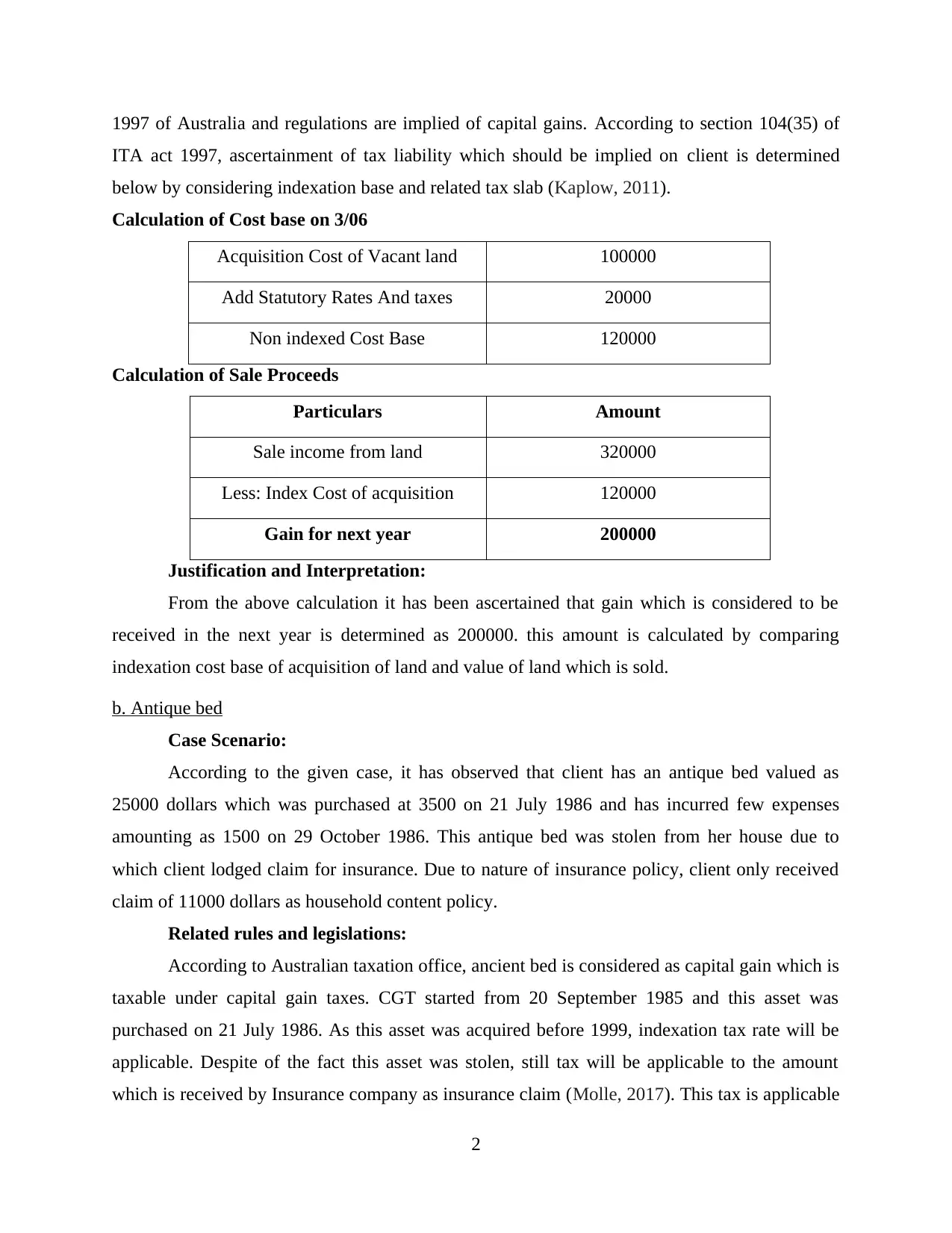
1997 of Australia and regulations are implied of capital gains. According to section 104(35) of
ITA act 1997, ascertainment of tax liability which should be implied on client is determined
below by considering indexation base and related tax slab (Kaplow, 2011).
Calculation of Cost base on 3/06
Acquisition Cost of Vacant land 100000
Add Statutory Rates And taxes 20000
Non indexed Cost Base 120000
Calculation of Sale Proceeds
Particulars Amount
Sale income from land 320000
Less: Index Cost of acquisition 120000
Gain for next year 200000
Justification and Interpretation:
From the above calculation it has been ascertained that gain which is considered to be
received in the next year is determined as 200000. this amount is calculated by comparing
indexation cost base of acquisition of land and value of land which is sold.
b. Antique bed
Case Scenario:
According to the given case, it has observed that client has an antique bed valued as
25000 dollars which was purchased at 3500 on 21 July 1986 and has incurred few expenses
amounting as 1500 on 29 October 1986. This antique bed was stolen from her house due to
which client lodged claim for insurance. Due to nature of insurance policy, client only received
claim of 11000 dollars as household content policy.
Related rules and legislations:
According to Australian taxation office, ancient bed is considered as capital gain which is
taxable under capital gain taxes. CGT started from 20 September 1985 and this asset was
purchased on 21 July 1986. As this asset was acquired before 1999, indexation tax rate will be
applicable. Despite of the fact this asset was stolen, still tax will be applicable to the amount
which is received by Insurance company as insurance claim (Molle, 2017). This tax is applicable
2
ITA act 1997, ascertainment of tax liability which should be implied on client is determined
below by considering indexation base and related tax slab (Kaplow, 2011).
Calculation of Cost base on 3/06
Acquisition Cost of Vacant land 100000
Add Statutory Rates And taxes 20000
Non indexed Cost Base 120000
Calculation of Sale Proceeds
Particulars Amount
Sale income from land 320000
Less: Index Cost of acquisition 120000
Gain for next year 200000
Justification and Interpretation:
From the above calculation it has been ascertained that gain which is considered to be
received in the next year is determined as 200000. this amount is calculated by comparing
indexation cost base of acquisition of land and value of land which is sold.
b. Antique bed
Case Scenario:
According to the given case, it has observed that client has an antique bed valued as
25000 dollars which was purchased at 3500 on 21 July 1986 and has incurred few expenses
amounting as 1500 on 29 October 1986. This antique bed was stolen from her house due to
which client lodged claim for insurance. Due to nature of insurance policy, client only received
claim of 11000 dollars as household content policy.
Related rules and legislations:
According to Australian taxation office, ancient bed is considered as capital gain which is
taxable under capital gain taxes. CGT started from 20 September 1985 and this asset was
purchased on 21 July 1986. As this asset was acquired before 1999, indexation tax rate will be
applicable. Despite of the fact this asset was stolen, still tax will be applicable to the amount
which is received by Insurance company as insurance claim (Molle, 2017). This tax is applicable
2
Paraphrase This Document
Need a fresh take? Get an instant paraphrase of this document with our AI Paraphraser
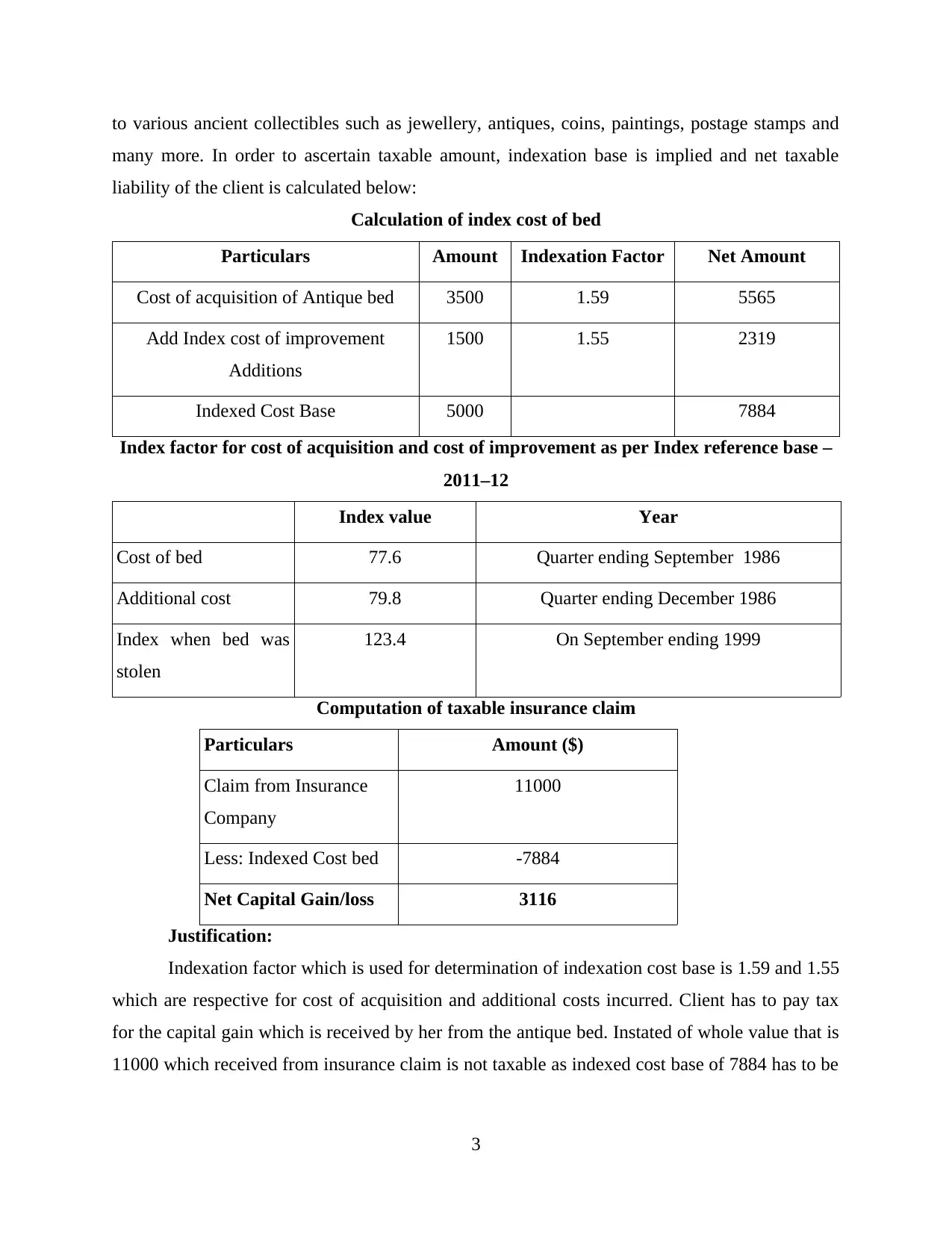
to various ancient collectibles such as jewellery, antiques, coins, paintings, postage stamps and
many more. In order to ascertain taxable amount, indexation base is implied and net taxable
liability of the client is calculated below:
Calculation of index cost of bed
Particulars Amount Indexation Factor Net Amount
Cost of acquisition of Antique bed 3500 1.59 5565
Add Index cost of improvement
Additions
1500 1.55 2319
Indexed Cost Base 5000 7884
Index factor for cost of acquisition and cost of improvement as per Index reference base –
2011–12
Index value Year
Cost of bed 77.6 Quarter ending September 1986
Additional cost 79.8 Quarter ending December 1986
Index when bed was
stolen
123.4 On September ending 1999
Computation of taxable insurance claim
Particulars Amount ($)
Claim from Insurance
Company
11000
Less: Indexed Cost bed -7884
Net Capital Gain/loss 3116
Justification:
Indexation factor which is used for determination of indexation cost base is 1.59 and 1.55
which are respective for cost of acquisition and additional costs incurred. Client has to pay tax
for the capital gain which is received by her from the antique bed. Instated of whole value that is
11000 which received from insurance claim is not taxable as indexed cost base of 7884 has to be
3
many more. In order to ascertain taxable amount, indexation base is implied and net taxable
liability of the client is calculated below:
Calculation of index cost of bed
Particulars Amount Indexation Factor Net Amount
Cost of acquisition of Antique bed 3500 1.59 5565
Add Index cost of improvement
Additions
1500 1.55 2319
Indexed Cost Base 5000 7884
Index factor for cost of acquisition and cost of improvement as per Index reference base –
2011–12
Index value Year
Cost of bed 77.6 Quarter ending September 1986
Additional cost 79.8 Quarter ending December 1986
Index when bed was
stolen
123.4 On September ending 1999
Computation of taxable insurance claim
Particulars Amount ($)
Claim from Insurance
Company
11000
Less: Indexed Cost bed -7884
Net Capital Gain/loss 3116
Justification:
Indexation factor which is used for determination of indexation cost base is 1.59 and 1.55
which are respective for cost of acquisition and additional costs incurred. Client has to pay tax
for the capital gain which is received by her from the antique bed. Instated of whole value that is
11000 which received from insurance claim is not taxable as indexed cost base of 7884 has to be
3
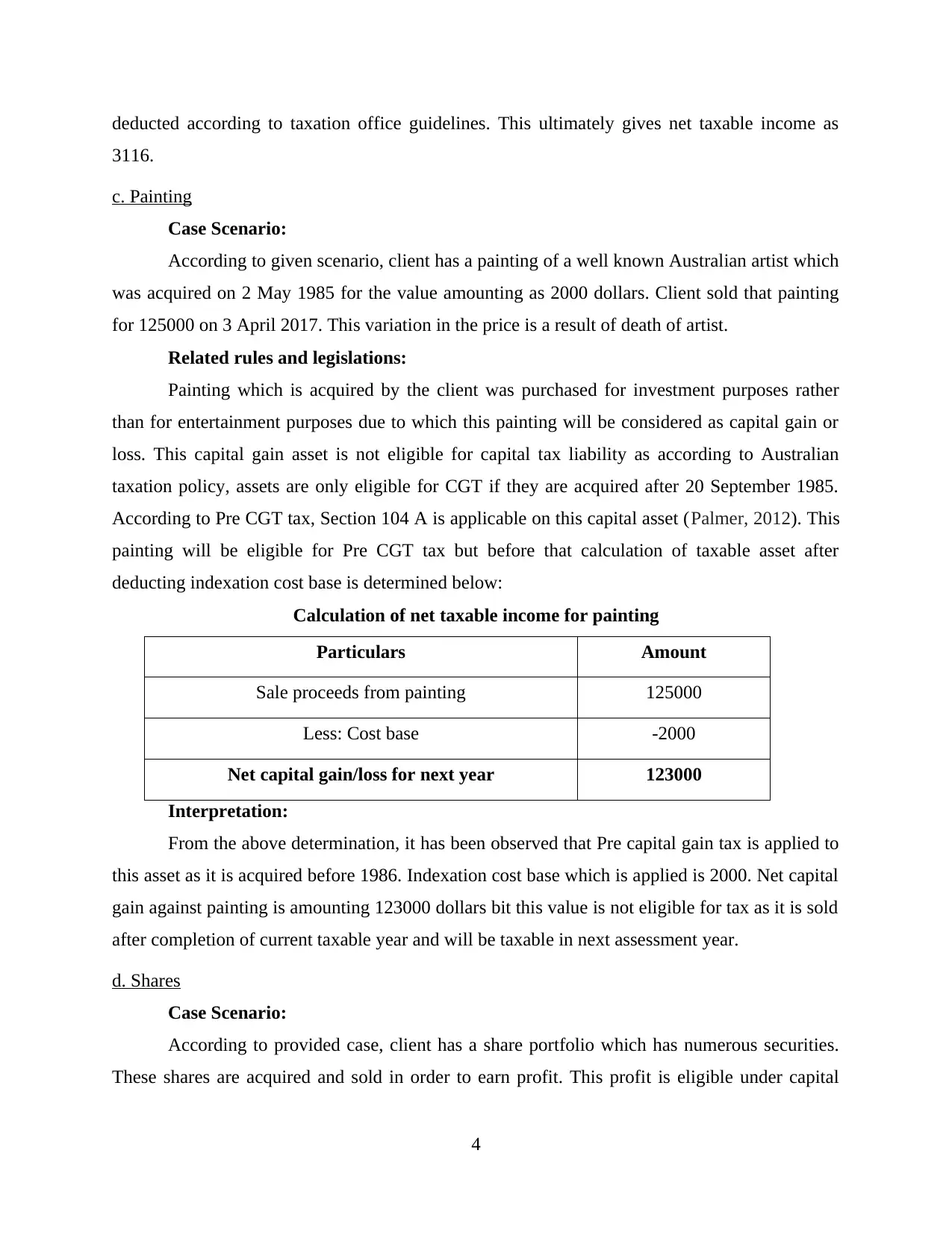
deducted according to taxation office guidelines. This ultimately gives net taxable income as
3116.
c. Painting
Case Scenario:
According to given scenario, client has a painting of a well known Australian artist which
was acquired on 2 May 1985 for the value amounting as 2000 dollars. Client sold that painting
for 125000 on 3 April 2017. This variation in the price is a result of death of artist.
Related rules and legislations:
Painting which is acquired by the client was purchased for investment purposes rather
than for entertainment purposes due to which this painting will be considered as capital gain or
loss. This capital gain asset is not eligible for capital tax liability as according to Australian
taxation policy, assets are only eligible for CGT if they are acquired after 20 September 1985.
According to Pre CGT tax, Section 104 A is applicable on this capital asset (Palmer, 2012). This
painting will be eligible for Pre CGT tax but before that calculation of taxable asset after
deducting indexation cost base is determined below:
Calculation of net taxable income for painting
Particulars Amount
Sale proceeds from painting 125000
Less: Cost base -2000
Net capital gain/loss for next year 123000
Interpretation:
From the above determination, it has been observed that Pre capital gain tax is applied to
this asset as it is acquired before 1986. Indexation cost base which is applied is 2000. Net capital
gain against painting is amounting 123000 dollars bit this value is not eligible for tax as it is sold
after completion of current taxable year and will be taxable in next assessment year.
d. Shares
Case Scenario:
According to provided case, client has a share portfolio which has numerous securities.
These shares are acquired and sold in order to earn profit. This profit is eligible under capital
4
3116.
c. Painting
Case Scenario:
According to given scenario, client has a painting of a well known Australian artist which
was acquired on 2 May 1985 for the value amounting as 2000 dollars. Client sold that painting
for 125000 on 3 April 2017. This variation in the price is a result of death of artist.
Related rules and legislations:
Painting which is acquired by the client was purchased for investment purposes rather
than for entertainment purposes due to which this painting will be considered as capital gain or
loss. This capital gain asset is not eligible for capital tax liability as according to Australian
taxation policy, assets are only eligible for CGT if they are acquired after 20 September 1985.
According to Pre CGT tax, Section 104 A is applicable on this capital asset (Palmer, 2012). This
painting will be eligible for Pre CGT tax but before that calculation of taxable asset after
deducting indexation cost base is determined below:
Calculation of net taxable income for painting
Particulars Amount
Sale proceeds from painting 125000
Less: Cost base -2000
Net capital gain/loss for next year 123000
Interpretation:
From the above determination, it has been observed that Pre capital gain tax is applied to
this asset as it is acquired before 1986. Indexation cost base which is applied is 2000. Net capital
gain against painting is amounting 123000 dollars bit this value is not eligible for tax as it is sold
after completion of current taxable year and will be taxable in next assessment year.
d. Shares
Case Scenario:
According to provided case, client has a share portfolio which has numerous securities.
These shares are acquired and sold in order to earn profit. This profit is eligible under capital
4
⊘ This is a preview!⊘
Do you want full access?
Subscribe today to unlock all pages.

Trusted by 1+ million students worldwide
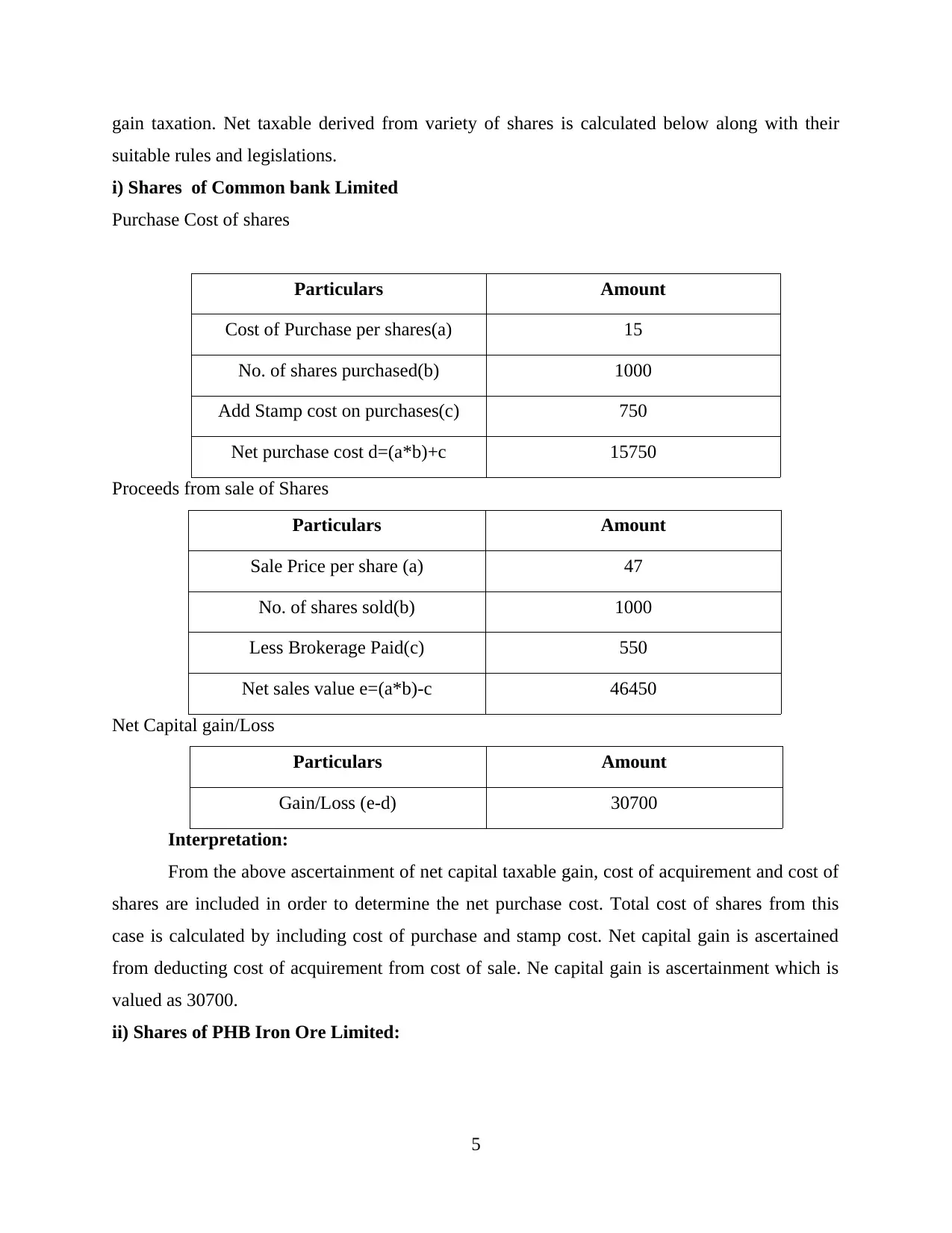
gain taxation. Net taxable derived from variety of shares is calculated below along with their
suitable rules and legislations.
i) Shares of Common bank Limited
Purchase Cost of shares
Particulars Amount
Cost of Purchase per shares(a) 15
No. of shares purchased(b) 1000
Add Stamp cost on purchases(c) 750
Net purchase cost d=(a*b)+c 15750
Proceeds from sale of Shares
Particulars Amount
Sale Price per share (a) 47
No. of shares sold(b) 1000
Less Brokerage Paid(c) 550
Net sales value e=(a*b)-c 46450
Net Capital gain/Loss
Particulars Amount
Gain/Loss (e-d) 30700
Interpretation:
From the above ascertainment of net capital taxable gain, cost of acquirement and cost of
shares are included in order to determine the net purchase cost. Total cost of shares from this
case is calculated by including cost of purchase and stamp cost. Net capital gain is ascertained
from deducting cost of acquirement from cost of sale. Ne capital gain is ascertainment which is
valued as 30700.
ii) Shares of PHB Iron Ore Limited:
5
suitable rules and legislations.
i) Shares of Common bank Limited
Purchase Cost of shares
Particulars Amount
Cost of Purchase per shares(a) 15
No. of shares purchased(b) 1000
Add Stamp cost on purchases(c) 750
Net purchase cost d=(a*b)+c 15750
Proceeds from sale of Shares
Particulars Amount
Sale Price per share (a) 47
No. of shares sold(b) 1000
Less Brokerage Paid(c) 550
Net sales value e=(a*b)-c 46450
Net Capital gain/Loss
Particulars Amount
Gain/Loss (e-d) 30700
Interpretation:
From the above ascertainment of net capital taxable gain, cost of acquirement and cost of
shares are included in order to determine the net purchase cost. Total cost of shares from this
case is calculated by including cost of purchase and stamp cost. Net capital gain is ascertained
from deducting cost of acquirement from cost of sale. Ne capital gain is ascertainment which is
valued as 30700.
ii) Shares of PHB Iron Ore Limited:
5
Paraphrase This Document
Need a fresh take? Get an instant paraphrase of this document with our AI Paraphraser
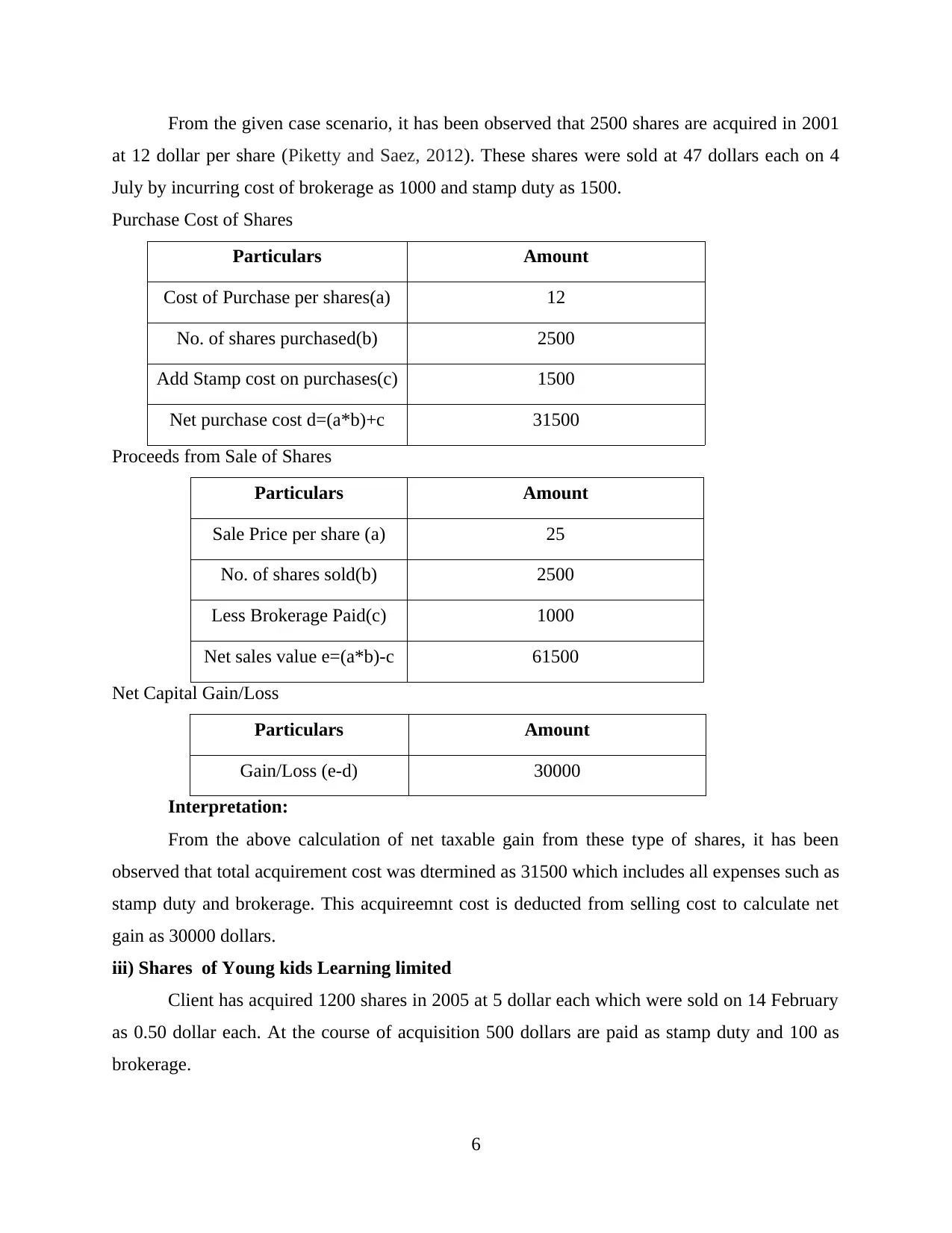
From the given case scenario, it has been observed that 2500 shares are acquired in 2001
at 12 dollar per share (Piketty and Saez, 2012). These shares were sold at 47 dollars each on 4
July by incurring cost of brokerage as 1000 and stamp duty as 1500.
Purchase Cost of Shares
Particulars Amount
Cost of Purchase per shares(a) 12
No. of shares purchased(b) 2500
Add Stamp cost on purchases(c) 1500
Net purchase cost d=(a*b)+c 31500
Proceeds from Sale of Shares
Particulars Amount
Sale Price per share (a) 25
No. of shares sold(b) 2500
Less Brokerage Paid(c) 1000
Net sales value e=(a*b)-c 61500
Net Capital Gain/Loss
Particulars Amount
Gain/Loss (e-d) 30000
Interpretation:
From the above calculation of net taxable gain from these type of shares, it has been
observed that total acquirement cost was dtermined as 31500 which includes all expenses such as
stamp duty and brokerage. This acquireemnt cost is deducted from selling cost to calculate net
gain as 30000 dollars.
iii) Shares of Young kids Learning limited
Client has acquired 1200 shares in 2005 at 5 dollar each which were sold on 14 February
as 0.50 dollar each. At the course of acquisition 500 dollars are paid as stamp duty and 100 as
brokerage.
6
at 12 dollar per share (Piketty and Saez, 2012). These shares were sold at 47 dollars each on 4
July by incurring cost of brokerage as 1000 and stamp duty as 1500.
Purchase Cost of Shares
Particulars Amount
Cost of Purchase per shares(a) 12
No. of shares purchased(b) 2500
Add Stamp cost on purchases(c) 1500
Net purchase cost d=(a*b)+c 31500
Proceeds from Sale of Shares
Particulars Amount
Sale Price per share (a) 25
No. of shares sold(b) 2500
Less Brokerage Paid(c) 1000
Net sales value e=(a*b)-c 61500
Net Capital Gain/Loss
Particulars Amount
Gain/Loss (e-d) 30000
Interpretation:
From the above calculation of net taxable gain from these type of shares, it has been
observed that total acquirement cost was dtermined as 31500 which includes all expenses such as
stamp duty and brokerage. This acquireemnt cost is deducted from selling cost to calculate net
gain as 30000 dollars.
iii) Shares of Young kids Learning limited
Client has acquired 1200 shares in 2005 at 5 dollar each which were sold on 14 February
as 0.50 dollar each. At the course of acquisition 500 dollars are paid as stamp duty and 100 as
brokerage.
6
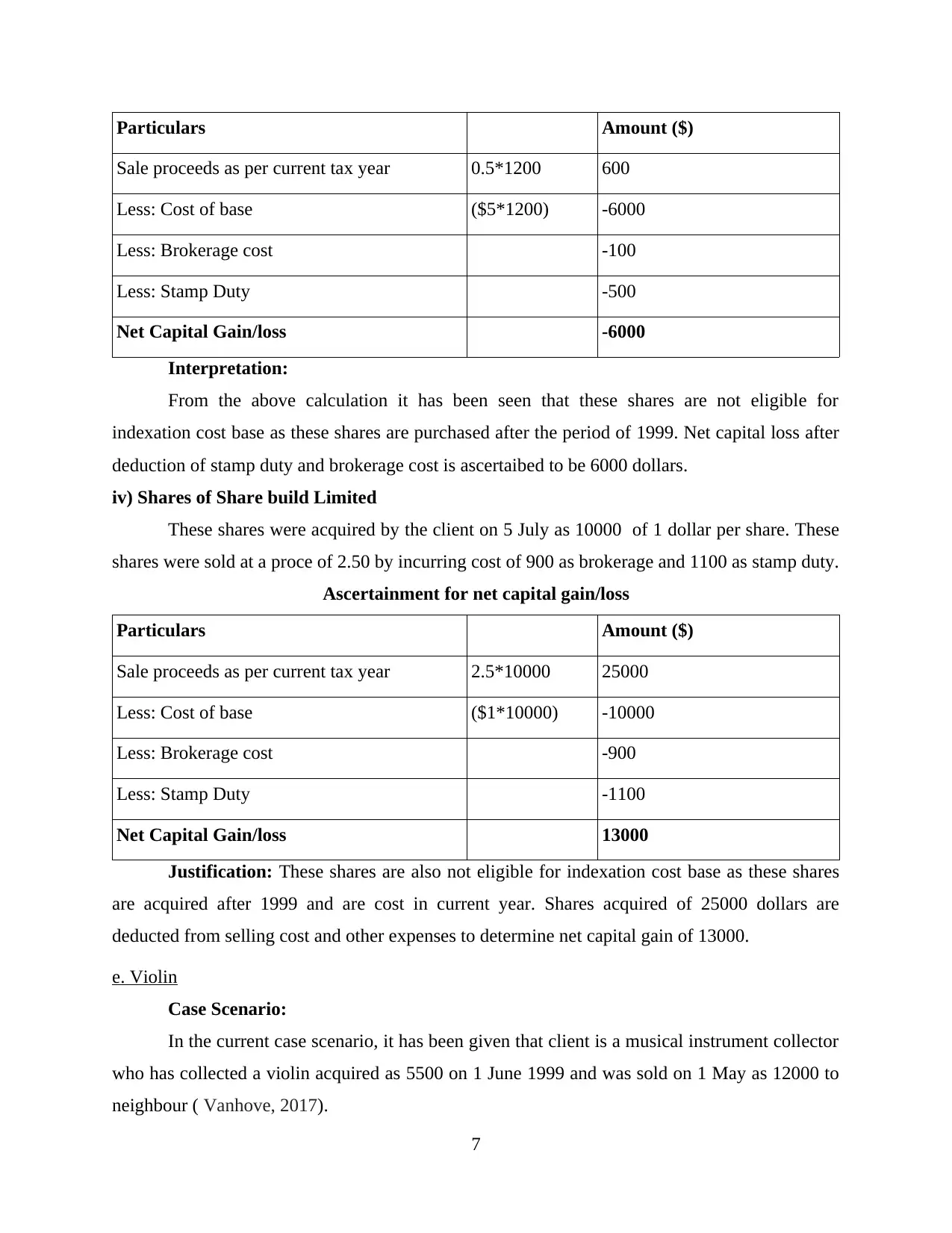
Particulars Amount ($)
Sale proceeds as per current tax year 0.5*1200 600
Less: Cost of base ($5*1200) -6000
Less: Brokerage cost -100
Less: Stamp Duty -500
Net Capital Gain/loss -6000
Interpretation:
From the above calculation it has been seen that these shares are not eligible for
indexation cost base as these shares are purchased after the period of 1999. Net capital loss after
deduction of stamp duty and brokerage cost is ascertaibed to be 6000 dollars.
iv) Shares of Share build Limited
These shares were acquired by the client on 5 July as 10000 of 1 dollar per share. These
shares were sold at a proce of 2.50 by incurring cost of 900 as brokerage and 1100 as stamp duty.
Ascertainment for net capital gain/loss
Particulars Amount ($)
Sale proceeds as per current tax year 2.5*10000 25000
Less: Cost of base ($1*10000) -10000
Less: Brokerage cost -900
Less: Stamp Duty -1100
Net Capital Gain/loss 13000
Justification: These shares are also not eligible for indexation cost base as these shares
are acquired after 1999 and are cost in current year. Shares acquired of 25000 dollars are
deducted from selling cost and other expenses to determine net capital gain of 13000.
e. Violin
Case Scenario:
In the current case scenario, it has been given that client is a musical instrument collector
who has collected a violin acquired as 5500 on 1 June 1999 and was sold on 1 May as 12000 to
neighbour ( Vanhove, 2017).
7
Sale proceeds as per current tax year 0.5*1200 600
Less: Cost of base ($5*1200) -6000
Less: Brokerage cost -100
Less: Stamp Duty -500
Net Capital Gain/loss -6000
Interpretation:
From the above calculation it has been seen that these shares are not eligible for
indexation cost base as these shares are purchased after the period of 1999. Net capital loss after
deduction of stamp duty and brokerage cost is ascertaibed to be 6000 dollars.
iv) Shares of Share build Limited
These shares were acquired by the client on 5 July as 10000 of 1 dollar per share. These
shares were sold at a proce of 2.50 by incurring cost of 900 as brokerage and 1100 as stamp duty.
Ascertainment for net capital gain/loss
Particulars Amount ($)
Sale proceeds as per current tax year 2.5*10000 25000
Less: Cost of base ($1*10000) -10000
Less: Brokerage cost -900
Less: Stamp Duty -1100
Net Capital Gain/loss 13000
Justification: These shares are also not eligible for indexation cost base as these shares
are acquired after 1999 and are cost in current year. Shares acquired of 25000 dollars are
deducted from selling cost and other expenses to determine net capital gain of 13000.
e. Violin
Case Scenario:
In the current case scenario, it has been given that client is a musical instrument collector
who has collected a violin acquired as 5500 on 1 June 1999 and was sold on 1 May as 12000 to
neighbour ( Vanhove, 2017).
7
⊘ This is a preview!⊘
Do you want full access?
Subscribe today to unlock all pages.

Trusted by 1+ million students worldwide
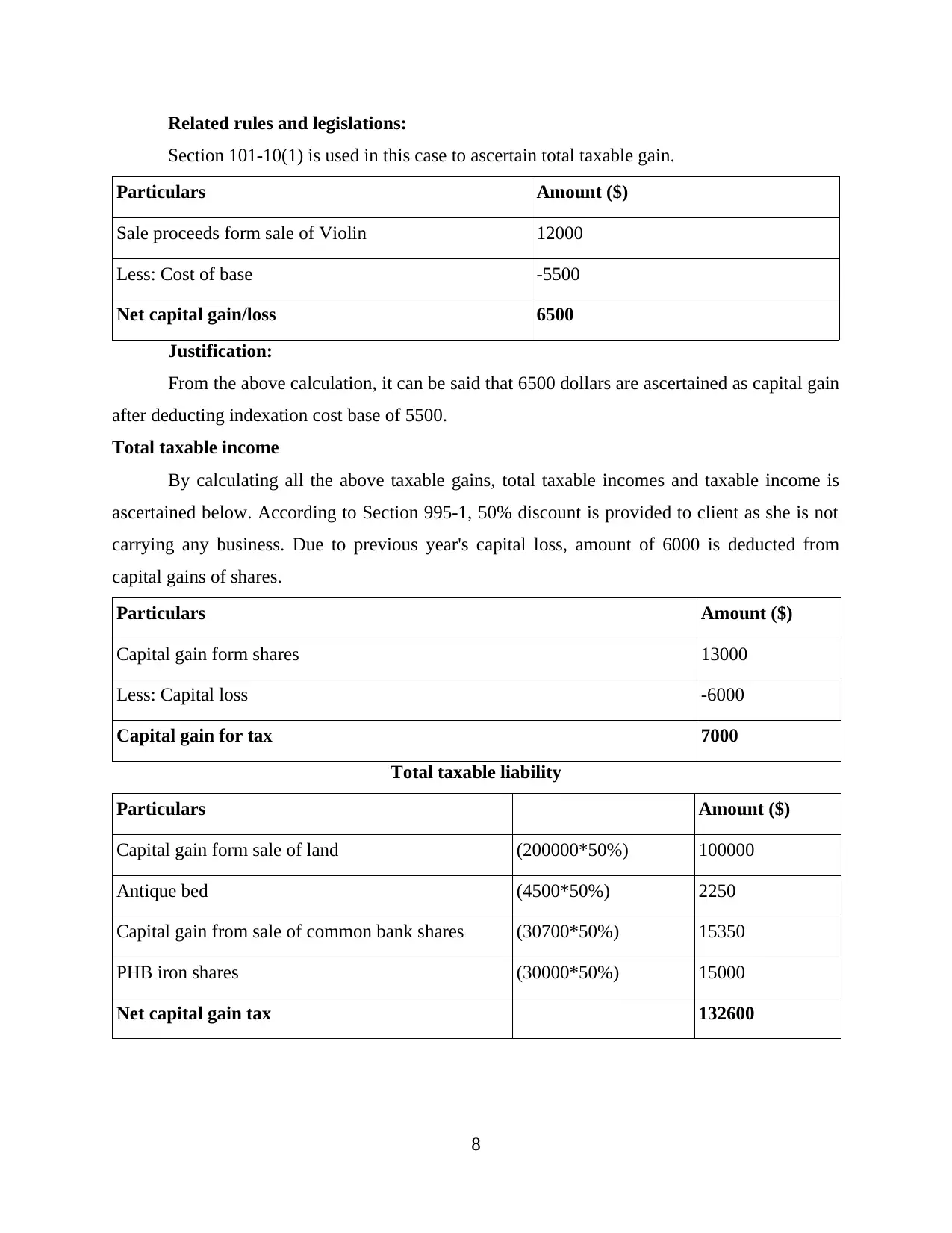
Related rules and legislations:
Section 101-10(1) is used in this case to ascertain total taxable gain.
Particulars Amount ($)
Sale proceeds form sale of Violin 12000
Less: Cost of base -5500
Net capital gain/loss 6500
Justification:
From the above calculation, it can be said that 6500 dollars are ascertained as capital gain
after deducting indexation cost base of 5500.
Total taxable income
By calculating all the above taxable gains, total taxable incomes and taxable income is
ascertained below. According to Section 995-1, 50% discount is provided to client as she is not
carrying any business. Due to previous year's capital loss, amount of 6000 is deducted from
capital gains of shares.
Particulars Amount ($)
Capital gain form shares 13000
Less: Capital loss -6000
Capital gain for tax 7000
Total taxable liability
Particulars Amount ($)
Capital gain form sale of land (200000*50%) 100000
Antique bed (4500*50%) 2250
Capital gain from sale of common bank shares (30700*50%) 15350
PHB iron shares (30000*50%) 15000
Net capital gain tax 132600
8
Section 101-10(1) is used in this case to ascertain total taxable gain.
Particulars Amount ($)
Sale proceeds form sale of Violin 12000
Less: Cost of base -5500
Net capital gain/loss 6500
Justification:
From the above calculation, it can be said that 6500 dollars are ascertained as capital gain
after deducting indexation cost base of 5500.
Total taxable income
By calculating all the above taxable gains, total taxable incomes and taxable income is
ascertained below. According to Section 995-1, 50% discount is provided to client as she is not
carrying any business. Due to previous year's capital loss, amount of 6000 is deducted from
capital gains of shares.
Particulars Amount ($)
Capital gain form shares 13000
Less: Capital loss -6000
Capital gain for tax 7000
Total taxable liability
Particulars Amount ($)
Capital gain form sale of land (200000*50%) 100000
Antique bed (4500*50%) 2250
Capital gain from sale of common bank shares (30700*50%) 15350
PHB iron shares (30000*50%) 15000
Net capital gain tax 132600
8
Paraphrase This Document
Need a fresh take? Get an instant paraphrase of this document with our AI Paraphraser
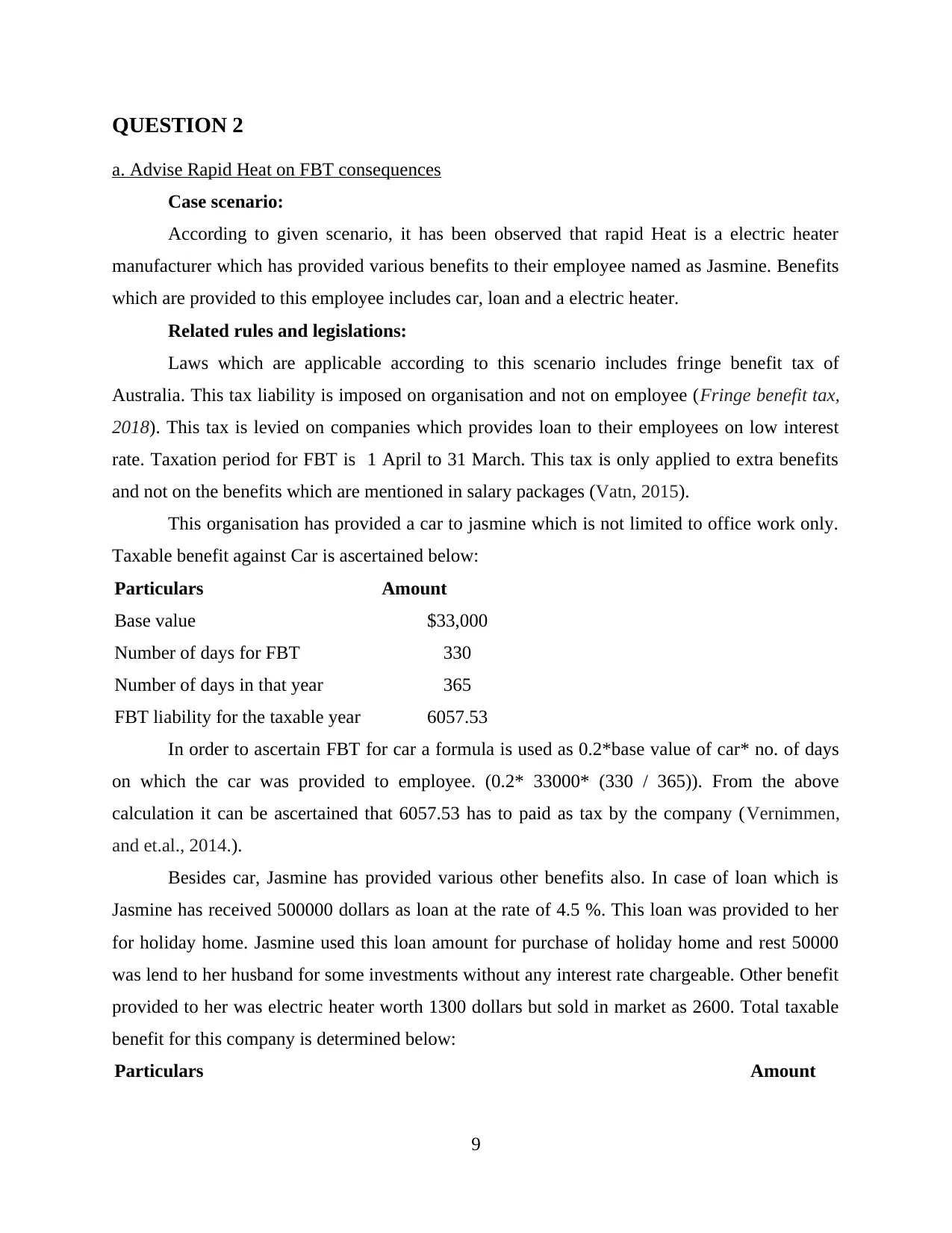
QUESTION 2
a. Advise Rapid Heat on FBT consequences
Case scenario:
According to given scenario, it has been observed that rapid Heat is a electric heater
manufacturer which has provided various benefits to their employee named as Jasmine. Benefits
which are provided to this employee includes car, loan and a electric heater.
Related rules and legislations:
Laws which are applicable according to this scenario includes fringe benefit tax of
Australia. This tax liability is imposed on organisation and not on employee (Fringe benefit tax,
2018). This tax is levied on companies which provides loan to their employees on low interest
rate. Taxation period for FBT is 1 April to 31 March. This tax is only applied to extra benefits
and not on the benefits which are mentioned in salary packages (Vatn, 2015).
This organisation has provided a car to jasmine which is not limited to office work only.
Taxable benefit against Car is ascertained below:
Particulars Amount
Base value $33,000
Number of days for FBT 330
Number of days in that year 365
FBT liability for the taxable year 6057.53
In order to ascertain FBT for car a formula is used as 0.2*base value of car* no. of days
on which the car was provided to employee. (0.2* 33000* (330 / 365)). From the above
calculation it can be ascertained that 6057.53 has to paid as tax by the company (Vernimmen,
and et.al., 2014.).
Besides car, Jasmine has provided various other benefits also. In case of loan which is
Jasmine has received 500000 dollars as loan at the rate of 4.5 %. This loan was provided to her
for holiday home. Jasmine used this loan amount for purchase of holiday home and rest 50000
was lend to her husband for some investments without any interest rate chargeable. Other benefit
provided to her was electric heater worth 1300 dollars but sold in market as 2600. Total taxable
benefit for this company is determined below:
Particulars Amount
9
a. Advise Rapid Heat on FBT consequences
Case scenario:
According to given scenario, it has been observed that rapid Heat is a electric heater
manufacturer which has provided various benefits to their employee named as Jasmine. Benefits
which are provided to this employee includes car, loan and a electric heater.
Related rules and legislations:
Laws which are applicable according to this scenario includes fringe benefit tax of
Australia. This tax liability is imposed on organisation and not on employee (Fringe benefit tax,
2018). This tax is levied on companies which provides loan to their employees on low interest
rate. Taxation period for FBT is 1 April to 31 March. This tax is only applied to extra benefits
and not on the benefits which are mentioned in salary packages (Vatn, 2015).
This organisation has provided a car to jasmine which is not limited to office work only.
Taxable benefit against Car is ascertained below:
Particulars Amount
Base value $33,000
Number of days for FBT 330
Number of days in that year 365
FBT liability for the taxable year 6057.53
In order to ascertain FBT for car a formula is used as 0.2*base value of car* no. of days
on which the car was provided to employee. (0.2* 33000* (330 / 365)). From the above
calculation it can be ascertained that 6057.53 has to paid as tax by the company (Vernimmen,
and et.al., 2014.).
Besides car, Jasmine has provided various other benefits also. In case of loan which is
Jasmine has received 500000 dollars as loan at the rate of 4.5 %. This loan was provided to her
for holiday home. Jasmine used this loan amount for purchase of holiday home and rest 50000
was lend to her husband for some investments without any interest rate chargeable. Other benefit
provided to her was electric heater worth 1300 dollars but sold in market as 2600. Total taxable
benefit for this company is determined below:
Particulars Amount
9
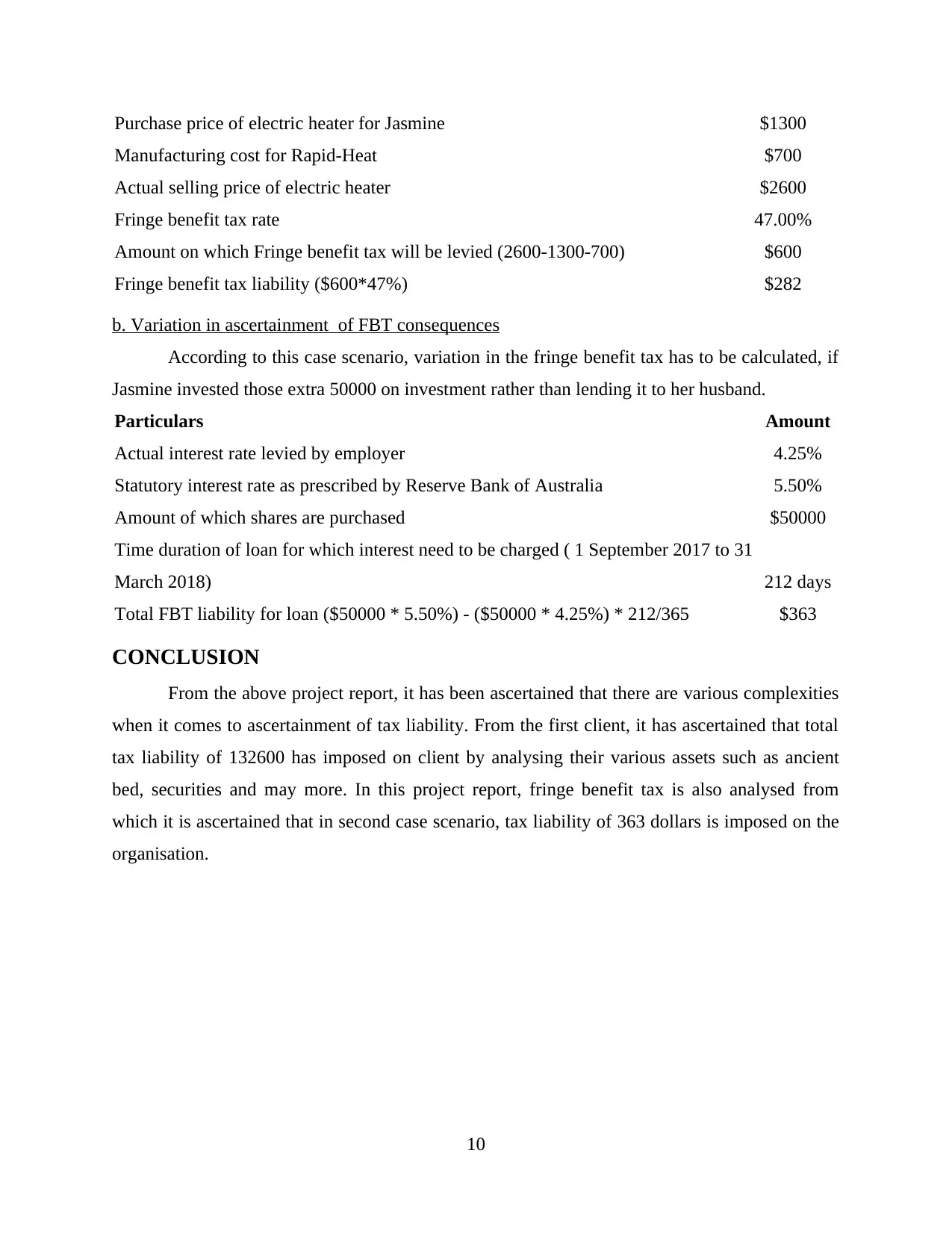
Purchase price of electric heater for Jasmine $1300
Manufacturing cost for Rapid-Heat $700
Actual selling price of electric heater $2600
Fringe benefit tax rate 47.00%
Amount on which Fringe benefit tax will be levied (2600-1300-700) $600
Fringe benefit tax liability ($600*47%) $282
b. Variation in ascertainment of FBT consequences
According to this case scenario, variation in the fringe benefit tax has to be calculated, if
Jasmine invested those extra 50000 on investment rather than lending it to her husband.
Particulars Amount
Actual interest rate levied by employer 4.25%
Statutory interest rate as prescribed by Reserve Bank of Australia 5.50%
Amount of which shares are purchased $50000
Time duration of loan for which interest need to be charged ( 1 September 2017 to 31
March 2018) 212 days
Total FBT liability for loan ($50000 * 5.50%) - ($50000 * 4.25%) * 212/365 $363
CONCLUSION
From the above project report, it has been ascertained that there are various complexities
when it comes to ascertainment of tax liability. From the first client, it has ascertained that total
tax liability of 132600 has imposed on client by analysing their various assets such as ancient
bed, securities and may more. In this project report, fringe benefit tax is also analysed from
which it is ascertained that in second case scenario, tax liability of 363 dollars is imposed on the
organisation.
10
Manufacturing cost for Rapid-Heat $700
Actual selling price of electric heater $2600
Fringe benefit tax rate 47.00%
Amount on which Fringe benefit tax will be levied (2600-1300-700) $600
Fringe benefit tax liability ($600*47%) $282
b. Variation in ascertainment of FBT consequences
According to this case scenario, variation in the fringe benefit tax has to be calculated, if
Jasmine invested those extra 50000 on investment rather than lending it to her husband.
Particulars Amount
Actual interest rate levied by employer 4.25%
Statutory interest rate as prescribed by Reserve Bank of Australia 5.50%
Amount of which shares are purchased $50000
Time duration of loan for which interest need to be charged ( 1 September 2017 to 31
March 2018) 212 days
Total FBT liability for loan ($50000 * 5.50%) - ($50000 * 4.25%) * 212/365 $363
CONCLUSION
From the above project report, it has been ascertained that there are various complexities
when it comes to ascertainment of tax liability. From the first client, it has ascertained that total
tax liability of 132600 has imposed on client by analysing their various assets such as ancient
bed, securities and may more. In this project report, fringe benefit tax is also analysed from
which it is ascertained that in second case scenario, tax liability of 363 dollars is imposed on the
organisation.
10
⊘ This is a preview!⊘
Do you want full access?
Subscribe today to unlock all pages.

Trusted by 1+ million students worldwide
1 out of 12
Related Documents
Your All-in-One AI-Powered Toolkit for Academic Success.
+13062052269
info@desklib.com
Available 24*7 on WhatsApp / Email
![[object Object]](/_next/static/media/star-bottom.7253800d.svg)
Unlock your academic potential
Copyright © 2020–2025 A2Z Services. All Rights Reserved. Developed and managed by ZUCOL.





